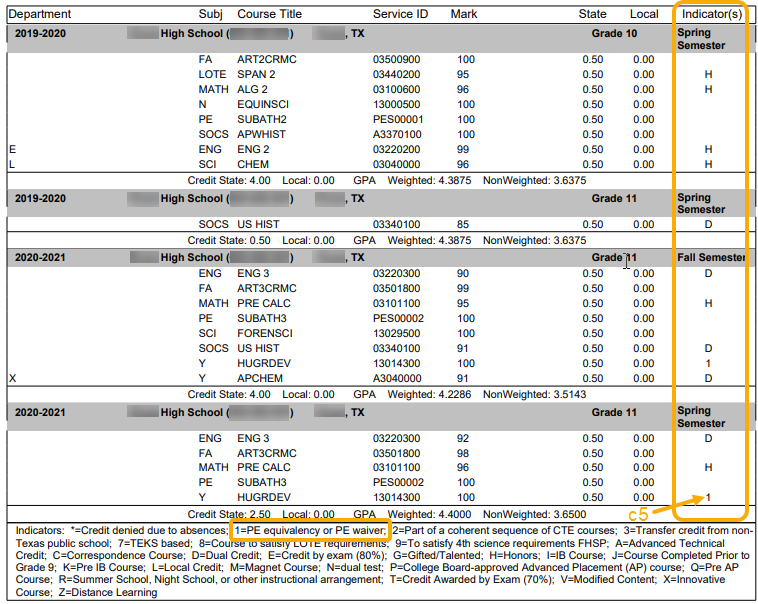This page is licensed under Creative Commons under Attribution 4.0 International. Anyone can share content from this page, with attribution and link to College MatchPoint requested.
How Will Colleges Read A Student's Transcript?
Your high school transcript is more than just a record of grades—it’s a window into your academic journey and potential. Admissions officers use it to evaluate your course selections, academic rigor, and growth over time, all within the context of your school’s offerings. Understanding how your transcript is assessed can help you make strategic choices that showcase your strengths and align with your goals. Whether you’re navigating AP courses, considering GPA trends, or reviewing your school’s profile, every detail on your transcript contributes to your story as a student. Let’s explore how colleges analyze transcripts and what steps you can take to make yours stand out.

So what exactly are readers looking at when they review a transcript? Colleges consider six key ways colleges will read a student’s transcript as part of the admissions read:
1. What Courses Has Your Student Taken?
Colleges pay close attention to the specific courses on a student’s transcript. This involves evaluating both the type and difficulty of courses taken.
- Major-Specific Prerequisites: For example, STEM majors often require calculus and advanced sciences. Humanities-focused students might need to show strength in literature or history.
- Electives Matter: Admission officers also look at electives to identify a student’s interests and willingness to explore diverse academic fields. Challenging electives aligned with personal interests can make a strong impression.
- Academic Rigor: Admissions officers assess whether a student challenged themselves with Advanced Placement (AP), International Baccalaureate (IB), or Honors courses. Did they pursue rigor without their grades suffering?
Takeaway: Students should choose classes that challenge them academically, align with their interests, and prepare them for their intended major. Approach all courses—majors and electives—with consistent effort and dedication.
2. What Is Your Student's Academic Core GPA?
While overall GPA is important, many colleges focus on grades earned in core academic areas: English, History/Social Science, Foreign Language, Math, and Science. Some schools recalculate GPA to reflect only these courses, using weighted or unweighted systems to evaluate academic potential accurately.
- Weighted vs. Unweighted GPA: Unweighted GPA assigns point values (out of 4) to grades without considering class difficulty. Weighted GPA adds extra points for advanced courses like AP, IB, or Honors.
- Recalculated GPA: Some colleges use algorithms to exclude courses like physical education, ensuring the GPA reflects academic rigor. Others simply review the grades as presented.
Takeaway: Focus on strong performance in core academic subjects while leveraging advanced coursework for additional rigor. It’s also beneficial to reach out to admissions representatives to learn how specific colleges evaluate GPAs.
3. What Are Your Student’s Transcript Trends?
Admissions officers look for trends in academic performance:
- Upward Trends: Improvements in grades over time—from B’s in freshman year to A’s by junior year—can show growth and resilience.
- Downward Trends: Declining grades, especially in junior or senior year, may raise concerns unless valid reasons (e.g., health issues) are provided in the application.
Students should use the “Additional Information” section of their application or counselor recommendations to explain any anomalies in their transcript.
Takeaway: Colleges value growth. Encourage students to focus on improving grades and maintaining strong performance throughout high school.
4. How Are Transcripts Sent to Colleges?
Understanding how transcripts are sent is essential:
- Official vs. Unofficial Transcripts: Official transcripts are sent directly from a high school to a college, often sealed or watermarked for authenticity. Unofficial transcripts are printed or digital copies given directly to students for personal use and are not valid for official applications.
- Counselor’s Role: High school counselors are responsible for sending official transcripts to colleges. Students should schedule an appointment with their counselor to confirm the process and ensure all deadlines are met.
Takeaway: Stay in close communication with your counselor to ensure official transcripts are sent to colleges on time.
5. How Many AP Classes Should a Student Take?
The right number of AP courses varies for each student, depending on their goals, abilities, and the opportunities available at their school. Here are key factors to consider:
- Balance and Challenge: Colleges expect students to challenge themselves but not at the expense of their well-being or grades. Taking one to three AP courses in sophomore and junior years and three to five in senior year is a reasonable range for many students. Highly selective colleges may expect a rigorous load across multiple disciplines.
- Alignment with Goals: Students aiming for STEM programs should focus on AP courses like Calculus, Biology, Chemistry, or Physics, while aspiring humanities majors might prioritize AP Literature, History, or Foreign Language.
- School Context: Colleges consider the total number of AP courses offered by a student’s school. For example, taking six AP courses at a school offering eight may be viewed more favorably than taking six at a school offering fifteen.
- Personal Capacity: Students should evaluate their ability to manage AP coursework alongside extracurricular activities, jobs, and personal responsibilities. It’s better to excel in fewer AP classes than to struggle in many.
Takeaway: There’s no universal “right” number of AP courses. Students should aim to strike a balance between rigor, personal interests, and academic success.
6. What Courses Does Your Student’s High School Offer?
Admissions officers consider a student’s achievements in the context of their high school’s offerings. This includes:
- School Profile: Transcripts are often accompanied by a school profile that outlines academic offerings, student demographics, and grading policies. For example, schools with limited AP or IB courses won’t penalize students for not taking them.
- Proactive Learning: Students who pursue external coursework (e.g., community college classes, online programs) demonstrate initiative and intellectual curiosity.
Takeaway: Students should maximize the opportunities available at their school while considering external learning options to fill gaps or explore unique interests.
What Is a School Profile, and How Do Colleges Use It?
A school profile is a document that provides critical context for understanding a student’s transcript. Here is an example profile. It typically includes:
- Demographics: Information on the school’s student population, socioeconomic diversity, and geographic location.
- Academic Program: An outline of available courses, such as AP, IB, Honors, and dual enrollment options.
- Grading Policies: Details about GPA calculation, class rank (if applicable), and weighting systems.
- College Placement Data: Statistics on college matriculation rates and notable college acceptances.
Admissions officers use the school profile to assess a student’s academic performance within the context of their educational environment. For instance, a student with a rigorous course load at a school offering 10 AP courses might be evaluated differently than one at a school offering only 3 AP options.
Takeaway: Parents and students should review their school’s profile to understand how colleges will view their transcript in context. If a school profile isn’t readily available, request it from the counseling office.


